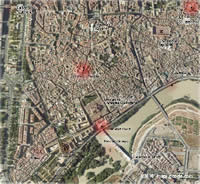The 21st Century Has Brought Big Changes to Cordoba
Cordoba Info
Cordoba Hotels
Restaurants
Food
Photos
Map
History
Monuments
Museums
Festivals
Events
News
Weather
Practical Info
Tips for visitors
Spanish courses
Province
About us
Email
- The 10 Biggest changes of the last decade
- What's new for tourists
If you visited Cordoba in the 1990s and come back now, you'll notice some big changes. Cordoba has been re-paving streets with cobblestones and attractive granite slabs. The City Hall is gradually replacing 19 th -century-style street lighting and park benches with modern fixtures. Urban planners have remodeled major squares, adding new fountains and re-directing traffic. Unsightly garbage dumpsters in the historic center have been hidden below street level. Picturesque streets once crowded with parked cars and busy with traffic are now pedestrian. Kilometers of new bike lanes connect the center with outlying neighborhoods. New parks have been opened, new bridges built across the Guadalquivir and a new ring road begun.
Change in a UNESCO Universal Heritage Site is always controversial. Cordoba's a small, traditional city with the largest historic center in Europe. Cordobans are proud of their city and want to preserve its special charm and traditions. Nevertheless, citizens also want their city to be a modern, livable place; and not just a pretty postcard. Cordoba's candidacy for European Capital of Culture 2016 is based not only on its important historic legacy, but also on its place within the cultural vanguard of Europe. Cordoba is no longer the quaint provincial city it was in the 1970s and 80s.
Changes for Tourists
Cordoba has done a lot to offer tourists a better holiday. Visitors to Cordoba will find new museums, new hotels, newly opened monuments and new ways to experience monuments.
Top 10 changes of the decade: [see map]
- The Cathedral and former Mosque of Cordoba opens its doors in for a night-time visit starting in the autumn of 2010 called "The Soul of Cordoba" in a joint effort by the Consorcium of Tourism and the Dioses of Cordoba. The last decade has also seen the excavation of mosaics from the 5th-century Basica of San Vicente and the expansion of the Cathedral's museums.
- Opening of the new Medina Azahara Museum on the Medina Azaraha archeological site (7 km from centre) and the expansion of Cordoba's archeological museum.
- Puerta del Puente (Bridge Gate): the monumental gate undergoes complete restoration in 2007. The inside of the monument becomes a photographic exhibition and the roof is opened as a viewing point. Currently, the road from the gate to the Alcazar along the river is undergoing major work to drop the street level back to the original level of the gate and the Roman bridge. A new Cordoba Visitor Centre is to be opened next door.
- Restoration of San Augustín and San Lorenzo churches. Route of the "Fernandine Churches" introduced.
- The Roman Bridge is closed to traffic in 2004 and the arches and supports undergo much-needed restoration work. The architect removes the 19th- and early 20th-paving and re-surfaces the bridge with granite. On the south bank, the Calahorra Tower is restored along with one of Cordoba's ancient mills.
- The Ribera District: Major urban renovation project in the Ribera neighborhood to the east of the Mezquita. Construction of the Miraflores Bridge and Miraflores Park on the opposite bank. The Chaple of the Martyrs is restored and the Water Mill Museum is opened.
- San Basilio: the neighborhood well known for its traditional patios is declared a pedestrian zone. The Royal Stables (Caballerizas Reales) are restored and re-opened. Weekly equestrian shows begin in 2010.
- Alcázar de los Reyes Cristianos: the castle undergoes major restoration work. Towers are opened to the public. A night-time visit to the gardens is currently under proposal. The nearby Arab baths are opened to the public.
- The Historic centre is made a semi-pedestrian zone. The city re-paves streets from Tendillas Square to the Mezquita and around the cathedral.
- Remodelling of Plaza de la Corredera (2001), Cordoba's 2nd-most important Square after Plaza de las Tendillas (remodelled in '99).
On the whole, Cordoba has come a long way in recenet years while respecting its heritage and historic monuments. Visitors will find Cordoba to be a modern European city which has made every effort to tastefully combine old and new.
 [see map]
[see map]
Tony Reed, 3 January 2011
about us | disclaimer ©2005-2014 Tony Reed
